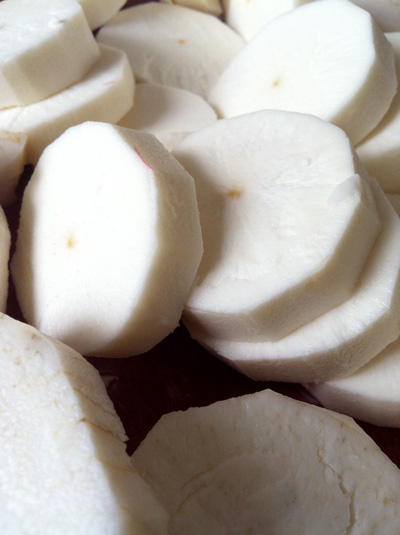Manioc Beer
I’ve been recently reading a little about the history of different cultural beers from around the world. Naturally, I would want to try them out myself and find a way to adapt them into “traditional” sense, in the way Dogfish Head does with their ancient ale series. (There’s a great article all about that in The Smithsonian Magazine.) One I’ve recently finished is a Manioc beer.
Manioc beer is a South American fermented beverage dating back 4,000 years. It’s main ingredient is the cassava root, also known as yuca (not yucca) root or a “real” yam. Cassava is a long, tuberous dark brown root that looks like it’s been covered in a waxy sugar. It is one of the largest sources of carbohydrates in the world and is extremely starchy.
The first step in turing this tuber into a beer is to peel and cook it. Cassava contains cyanide, which is destroyed by heat, which is one of the reasons it must first be fully cooked. Next comes the interesting part. The beer we are used to is made from barley, which also supplies a large amount of starch. However, yeast cannot break down the starches to produce the alcohol and CO2 (carbonation) we so highly desire. Therefore, the starches must be first converted to sugar. Luckily, the barley can do this for us by germinating it, aslo known as malting. The grains begin to grow by first producing enzymes that can convert to the stored energy in the starches into usable sugars for the plant. Therefore, by using malted barley, the brewer can ensure the starches are converted to sugars for the yeast.
Cassava root, however, cannot be malted to produce enzymes. Therefore, another method can be used to break down the starches. Every do that experiment in elementary school where you place a saltine cracker on your tongue and after a minute it becomes sweet? That’s because your saliva contains similar enzymes. And that’s the process manioc beer uses.
After cooking two good sized roots, I chewed and spit the mush into a pot. The, I added water and boiled for about an hour, while adding a little bit of mildly bitter hops. Once it was done, I stuck it in a fermenter with some yeast and let it ferment until completion for two weeks. I then primed with a little honey and bottled.
After two weeks I tried one. It’s quite strange. It’s very dry and bitter with not much flavor, mostly tasting minerally/metallic and  reminds me of seltzer water. I’m thinking of how best to adapt this to a more traditional beer. First, I think I will use a mix of grain and cassava, that way I do not need to do the mastication part. Secondly, I would use even less bittering hops and use more floral and spicy ones. Finally, I would even consider adding some fruit to it to add a little more flavor. The cassava straight up with some hops didn’t really taste that good, but I’m not ready to write it off yet.
The book where I learned about manioc beer (as well as many others) is Sacred and Herbal Healing Beers: The Secrets of Ancient Fermentation by Stephen Harrod Buhner and is available from Amazon.


